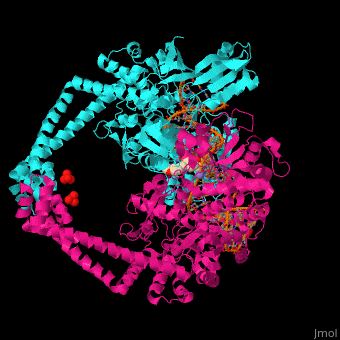Gyrase
From Proteopedia
(Difference between revisions)
| Line 3: | Line 3: | ||
<applet load='3l6v.pdb' size='350' frame='true' align='right' scene="Gyrase/Gyrase_starting_scene/1" caption= 'Crystal Structure of the Xanthomonas campestris Gyrase A C-terminal Domain, [[3l6v]]' /> | <applet load='3l6v.pdb' size='350' frame='true' align='right' scene="Gyrase/Gyrase_starting_scene/1" caption= 'Crystal Structure of the Xanthomonas campestris Gyrase A C-terminal Domain, [[3l6v]]' /> | ||
| - | '''Gyrase (Gyr)''' is a type of topoisomerase II in prokaryotes which unwinds double stranded DNA. The DNA Gyr cutting allows the formation of a negative DNA supercoil which enables replication of DNA. Gyr consists of 2 subunits: GyrA and GyrB. Reverse gyrase (Top-RG) is a type of topoisomerase I which catalyses the formation of positive DNA supercoil. | + | '''Gyrase (Gyr)''' is a type of topoisomerase II in prokaryotes which unwinds double stranded DNA. The DNA Gyr cutting allows the formation of a negative DNA supercoil which enables replication of DNA. Gyr consists of 2 subunits: GyrA and GyrB. Reverse gyrase (Top-RG) is a type of topoisomerase I which catalyses the formation of positive DNA supercoil.<ref>PMID:16397501<ref/> |
{{TOC limit|limit=2}} | {{TOC limit|limit=2}} | ||
Revision as of 06:17, 26 July 2010
Image:3L6V.jpg
Crystal Structure of Xanthomonas campestris Gyrase A C-terminal Domain, 3l6v
|
Gyrase (Gyr) is a type of topoisomerase II in prokaryotes which unwinds double stranded DNA. The DNA Gyr cutting allows the formation of a negative DNA supercoil which enables replication of DNA. Gyr consists of 2 subunits: GyrA and GyrB. Reverse gyrase (Top-RG) is a type of topoisomerase I which catalyses the formation of positive DNA supercoil.[1]
Proteopedia Page Contributors and Editors (what is this?)
Michal Harel, Alexander Berchansky, David Canner, Joel L. Sussman

